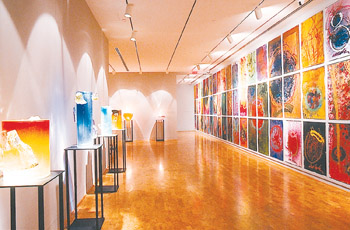 |
| Natural Cork’s Merida |
|
Hicksville, N.Y.—According to several industry executives, cork flooring, which has been seemingly rediscovered in recent years as evidenced by its increased use in public spaces via specifiers and the A&D community, not only looks good but is one of the more durable floor coverings on the market today.
“People’s perception about durability of cork floors is due to their lack of awareness about the product,” said Philippe Erramuzpe, COO of Natural Cork. “They tend to associate cork flooring to a bulletin board or a wine stopper and don’t realize the cork granules used in the composition of the flooring material are compressed to a high density in order to provide strength and durability.
“In addition, they are treated with technologically advanced protective finishes and can be maintained just like wood floors.”
“Cork has been used since the beginning of recorded time and respected as one of the most durable products that the Earth has ever given us,” said Barbara Napolitano, marketing manager for
Ceres Cork Flooring. “As a floor covering, most people fail to realize that cork was used in the early turn of the century, probably until the 1940s, as a workhorse floor, not a fashion item. It was used as an inexpensive, durable way to put down flooring in public spaces, not private spaces, court houses, libraries, all of these facilities had cork.
“The durability of cork is not only caused because it’s a closed air cell, which most people don’t realize,” she explained. “There is a make up to it. The other reason is that it compresses, so it’s more difficult to wear out from abrasion. It doesn’t fight the footstep. Everything else is rigid.
According to Rob McKee of
Expanko Cork, cork flooring is “an extremely durable flooring product due to the unique qualities of the raw material. Cork, the bark of the cork oak tree, has a unique cellular structure that allows it to be resilient, yet resists indentation and wear from normal use. While most people would think of a wine cork and the fact that it can be easily broken, cork flooring should not be compared. Unlike wine corks, cork flooring is manufactured by compressing the cork four times more than a wine cork. The result is a harder, more dense product.
“The addition of a protective coating,” he continued, “such as polyurethane seals the surface preventing damage from moisture and common cleaners as well as scratches and gouges. With all of that said, the proof is in actual installations, many of which are still in use 80 or more years after installation. Some of those installations include the U.S. Department of Commerce building in Washington, D.C., and Lafayette college law library, both of which are installed in heavy traffic areas and to this day are in excellent condition. Over the years, we have seen cork floors outlast stone and hardwood in numerous situations.”
“There are two constructions of cork flooring,” said Christopher Capobianco of
Flooring Answers, “homogeneous and veneer. The homogeneous products can be sanded and refinished just like a solid wooden floor so they are very durable and have been shown to last over 50 years when properly maintained.”
“The many benefits of cork flooring; ecological, sound absorbent, comfortable, and non-polluting, make it such that cork floors provide a good solution for use in commercial environments,” said Erramuzpe. “Attractive patterns and colors provide the designer with decorative options.”
“Cork flooring was actually a common commercial floor covering in the early 1900s when introduced by Armstrong,” said McKee. “It was selected for heavy traffic commercial applications not only due to its natural beauty, but because of its durability and ease of maintenance. Because solid cork floors can be sanded and refinished (like hardwood) it provides assurances that even under heavy use, sanding and recoating the surface will bring back the floor to its original state.
“Over the years,” he continued, “its commercial use decreased, however use in residential settings became popularized by architects such as Frank Lloyd Wright who used the product in many of his projects including Fallingwater.
“While cork is still used regularly in residential projects,” he added, “its use in commercial settings has been on the rise. This has been brought on by increased awareness and desire to use eco friendly products as well as a desire for durable, yet unique products. Improved installation, technical service and quality has aided significantly in this increase of use.”
“I’m hoping it will get even more popular in the commercial arena,” said Napolitano. “It was becoming popular as a fashion item. It has to be regarded as not only a fashion item but as a quality item. With the green movement going on right now in the U.S., there is the LEED points factor. That is the other important thing to recognize, is that cork is a crop. It’s the most natural product you can get. Trees are not cut down.
“With the green movement and the realization that cork is such a durable product,” she explained, “the swing will continue, especially in public spaces, in education, and there will continue to be momentum. The problem is, that many people pay lip service to it and do not understand it.”
“As with any other product categories,” concluded Erramuzpe, “there are different qualities offered today. Our company is now offering cork flooring treated with Microban to prevent mold and bacteria growth. We feature a new anti-scratch finish and sealed edges on our floating floors. We offer both a standard construction and a superior floating floor line. Natural Cork is a premier source for cork products offering; tiles, floating floors, underlayment, decorative wall tile, fabric and wallpaper.”
—Louis Iannaco